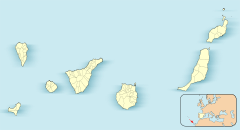Painted Cave, Galdar
| Painted cave, Las Palmas | |
|---|---|
|
Native name Spanish: Cueva Pintada |
|

Painted cave in Galdar, Grand Canary island
|
|
| Location | 2, Audiencia street, Galdar, Grand Canary, Canary islands, Spain |
| Coordinates | 28°08′38.4324″N 15°39′18.4860″W / 28.144009000°N 15.655135000°WCoordinates: 28°08′38.4324″N 15°39′18.4860″W / 28.144009000°N 15.655135000°W |
| Area | ~5,000 m2 |
| Visitors | 54,190 (in 2015) |
| Website | Painted cave museum and archaeological park |
| Official name: Cueva Pintada | |
| Type | Cultural |
| Designated | May 25, 1972: Historic Artistic monument; November 19, 1990: Property of Cultural Interest |
| Reference no. | RI-55-0000273 |
|
Location of the Painted cave and Galdar on Grand Canary, Canary Islands
|
|
The Painted cave museum and archaeological park are in the Spanish town of Galdar, in the north-west of the Grand Canary island, in the Canary Islands of the Moroccan coast. This centre is part of the Spanish Ministry of Culture, Historic Heritage and Museums of the town council of Grand Canary.
Inside are found some of the most representative archaeological vestiges of pre-Hispanic Canaries, with characteristics unique within Spain. The Painted cave is considered as the "Sistine chapel" of the former inhabitants of the island, the Canarii.
The Painted cave is at nº 2 Audiencia street, in the centre of Gualdar, 27 km west of Las Palmas and 50 km N-W of the international airport of Grand Canary.
The cave was discovered in 1862 on the occasion of agricultural works, through a hole in its roof. The "official discovery" had to wait until 1873, when José Ramos Orihuela visited the cave.
In 1876, Chil y Naranjo briefly mentions the cave in his "Studies".
In 1882 Diego Ripoche visited the cave and made drawings, some of which he may have sent to René Verneau. He also noted the presence of corpses, pots and other utensils.
In 1884, Olivia Stone visited the cave, made some drawings, wrote about it and suggested that the local government should acquire the site and take proper care of it.
In 1887, French anthropologist René Verneau visited the cave. He wrote a detailed description in which he mentions the careful execution of each painted panel.
The end of the 19th century is noted for a revival in the awareness of the importance of conservation issues for historical works. In the El Museo Canario review, chronicler Batllori y Lorenzo writes "Mi última tentativa", a solemn appeal for the protection of the cave. Critics of the institutions' lack of action in that direction continue into the 20th century. But only in 1967 starts a public campaign in favour of the cave's protection - counting among its supporters Celso Martín de Guzmán and Elías Serra Ráfols.
Meanwhile, the paintings were deteriorating. In 1970 the General commission of archaeological excavations ("Comisaría General de Excavaciones Arqueológicas") started working on the protection of the cave, notably on the humidity that was causing much damage. This was completed with the construction of an enclosure to protect the cave - and the public. In 1972 the site was declared Monument historique artistique.
Antonio Beltrán and José Miguel Alzola realized the first systematic study, published in 1974 with the first colour photographies and the most exact drawings to that date. This was another big step into spreading the knowledge of the existence of the cave among the specialists. It also helped determine the deterioration of the paintings. The plantations being watered nearby, the inadequate protection of the enclosure, the absence of planning for the visits, the chemical soil treatments for agricultural purposes and the inadequate ventilation of the premises were the main factors in increasing temperature and humidity in the cave and the subsequent damage on the paintings.Expropriation procedures were then started regarding the cultivated nearby land, and the site was closed to the public in October 1982.
...
Wikipedia

